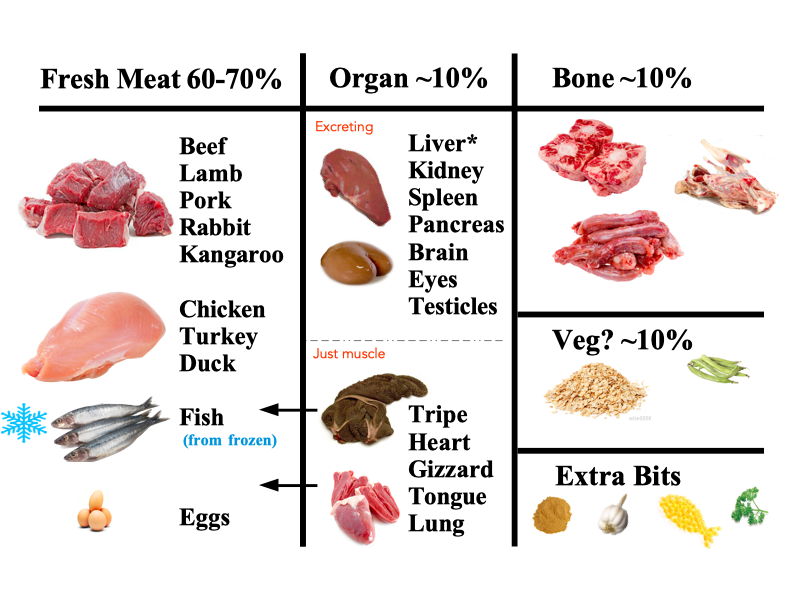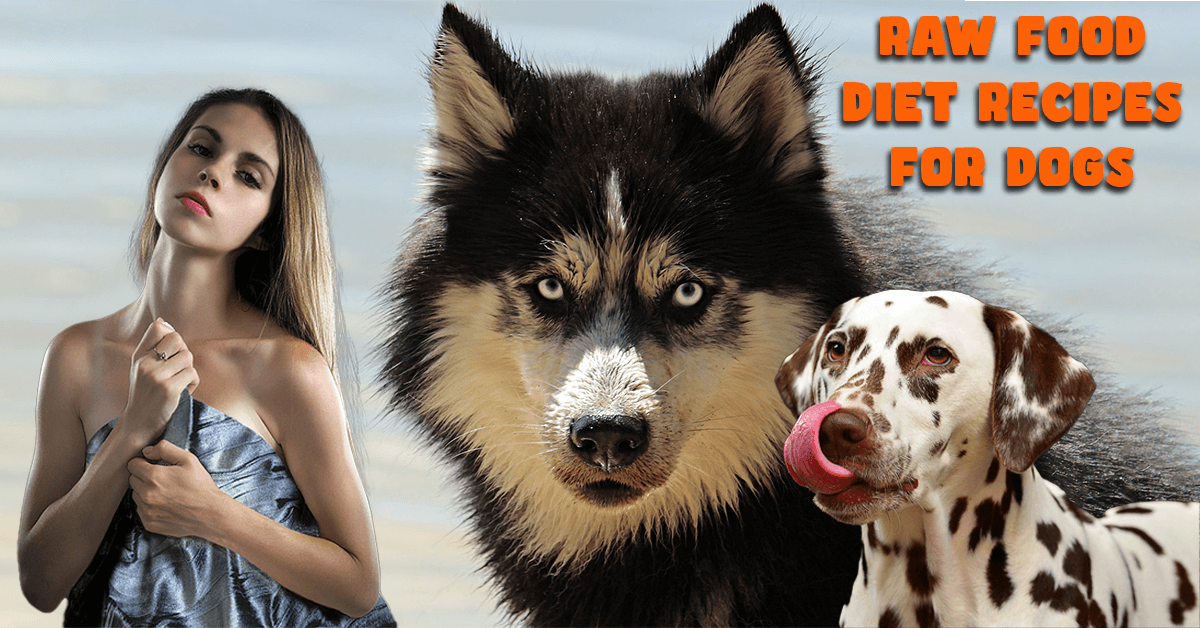Raw food diet recipes for dogs often include raw meats, bones, and vegetables. These diets aim to mimic a canine’s natural eating habits.
Embarking on a raw food journey for your dog can be a transformative step towards enhancing its health and vitality. Carefully crafted raw food recipes cater to dogs’ instinctual dietary patterns, focusing on unprocessed and fresh ingredients. This approach offers numerous benefits, including improved digestion, shinier coats, and increased energy levels.
Dog owners seeking to provide their pets with a more ancestral diet often consider raw food recipes to avoid the additives and preservatives in many commercial dog foods. By selecting the right balance of proteins, fats, and essential nutrients, these recipes can contribute to a well-rounded and natural canine diet. It’s crucial to consult with a veterinarian before making dietary changes to ensure the recipes meet your dog’s specific nutritional requirements.
Raw Food Diet Recipes for Dogs
An easy raw food diet for dogs includes simple, nutritious, cost-effective, and health-boosting recipes. Start with a base of lean meats like chicken, turkey, or beef, ensuring they are bones-free. Combine with organ meats for added nutrients and a variety of fresh, dog-safe vegetables like carrots, spinach, and broccoli.
Add healthy fats through fish or coconut oil and include a few fruits like apples or blueberries for vitamins and antioxidants. Preparing these meals in advance and freezing them can save time while ensuring your dog receives a balanced, raw diet tailored to their needs.
Introduction To Raw Food Diets For Dogs

Credit: www.dogsfirst.ie
Getting Started With Raw Feeding
Welcome to the world of raw feeding for dogs! Whether you’re a new pet parent or looking to switch up your furry friend’s diet, understanding the basics of raw food recipes is crucial. This natural approach to canine nutrition could lead to a happier, healthier pooch. Let’s dive into the essentials of starting your dog on a raw diet.
Basic Principles Of A Raw Diet
A raw diet for dogs typically includes:
- Meat: The main component, often consisting of muscle meat with or without bones.
- Organs: Vital for nutrients, organs should be a smaller portion of the diet.
- Bones: Raw, edible bones for calcium and oral health.
- Fruits and Vegetables: Provide fibre, vitamins, and minerals.
Balance is key. Dogs need a mix of protein, fat, and carbohydrates. Vets often suggest a ratio of 70% meat, 10% bone, and 20% fruits and veggies. Supplements like fish oil can be added for extra nutrients.
Transitioning Your Dog To Raw Foods
Switching your dog’s diet should be slow and steady. Here’s a simple plan:
- Start with one protein source. Use something your dog loves and digests well.
- Gradually mix raw food with their current diet. Increase the raw portion over a week.
- Monitor your dog’s reaction. Look for signs of digestive upset or allergies.
- Once adjusted, new proteins and variety are introduced.
During the transition, ensure fresh water is always available. Observe your dog’s feces as well. Firm, small, and less smelly stools suggest a successful switch.
Essential Ingredients For A Balanced Raw Diet
Let’s explore the essential ingredients for a balanced raw diet for dogs. Knowing what to include is crucial for their health and happiness.
Protein Sources: Choosing The Right Meats
Quality protein is vital for your dog’s muscle development and energy. Here are the top meats for a raw diet:
- Beef: Rich in iron and zinc.
- Chicken: A good source of lean protein.
- Lamb: High in essential fatty acids.
- Salmon: Packed with Omega-3 for healthy skin and coat.
Vegetables And Fruits: Vitamins And Minerals
Dogs also need vitamins and minerals from veggies and fruits. Include these in their diet:
| Vegetable/Fruit | Benefits |
|---|---|
| Carrots | Great for eyesight. |
| Blueberries | Full of antioxidants. |
| Spinach | Rich in vitamins A, C, and K. |
| Pumpkin | Helps with digestion. |
Remember, balance is key in a raw food diet for dogs. Ensure you provide a variety of these ingredients to meet their nutritional needs.

Simple Raw Food Recipes
Curious about raw food recipes for your dog? These simple meals could be a game-changer. A raw diet, rich in nutrients, may lead to a shinier coat, healthier skin, and more energy. Let’s explore two easy recipes that will have your furry friend’s tail wagging!
Basic Raw Chicken Meal
This recipe is a great starting point for raw food newbies. Chicken is a lean protein that supports muscle growth and energy.
- Ingredients:
- 2 pounds of raw chicken, including bones
- 1/2 pound raw chicken liver
- 1/2 pound raw chicken gizzard
- 1 cup of chopped leafy greens
Instructions:
- Grind the chicken bones carefully.
- Mix liver, gizzard, and chicken meat.
- Add chopped greens to the blend.
- Divide into portions based on your dog’s size.
Ensure bone pieces are small to prevent choking. Always supervise your dog during mealtime.
Beef And Organ Mix
This nutrient-dense recipe provides a variety of proteins and is packed with flavour.
| Ingredient | Amount |
|---|---|
| Raw beef (ground) | 2 pounds |
| Raw beef liver | 1/2 pound |
| Raw kidneys | 1/4 pound |
| Raw beef heart | 1/4 pound |
| Finely diced vegetables | 1 cup |
Instructions:
- Chop organs into small, bite-sized pieces.
- Mix all meats and organs together.
- Stir in diced vegetables for fibre.
- Portion the mix
Variety In Raw Meals
Every dog deserves a diet rich in variety. A raw food diet for dogs often focuses on meat but can include much more. Pet owners can create a balanced and exciting menu for their furry friends by adding different ingredients. Let’s explore how to infuse variety into raw meals with fish, eggs, and rotational feeding.
Incorporating Fish And Eggs
Fish and eggs add essential nutrients to a dog’s raw diet
. They are excellent sources of omega-3 fatty acids, vitamins, and minerals.
- Salmon and mackerel boost skin and coat health.
- Eggs provide high-quality protein and vital amino acids.
Include these foods once or twice a week. Always serve fish cooked or frozen to avoid parasites. Raw eggs can be mixed directly into your dog’s meal.
Rotational Feeding For Nutritional Diversity
Rotational feeding means switching up the proteins and veggies in your dog’s diet. This practice prevents nutrient deficiencies and food sensitivities.
- Start with a base protein like chicken or beef.
- Rotate to a new protein, such as lamb or turkey, after a few days.
- Introduce a variety of vegetables like spinach, carrots, and pumpkin.
This rotation ensures your dog gets a wide range of nutrients over time. Always transition foods gradually to avoid digestive upset.
Preparation And Storage Tips
Feeding your dog a raw food diet involves fresh ingredients and careful preparation. To ensure your furry friend enjoys their meals safely, follow these tips on handling and storing raw dog food.
Safe Handling Of Raw Ingredients
Start with quality ingredients from trusted sources. Use separate cutting boards for meats and vegetables. Keep kitchen surfaces clean to avoid cross-contamination. Always wash your hands before and after preparing meals.
- Use gloves when handling raw meat.
- Thaw frozen ingredients in the fridge, not on the counter.
- Prepare meals in batches to minimize handling.
Storing Raw Meals For Freshness
Proper storage keeps the raw food diet safe and nutritious for your dog. Use airtight containers to maintain freshness and prevent spills.
| Storage Type | Duration |
|---|---|
| Refrigerator | Up to 3 days |
| Freezer | 2-3 months |
- Label containers with prep dates.
- Keep raw food separate from other items in the fridge/freezer.
- Defrost meals overnight in the fridge before serving.
Supplements To Enhance Your Dog’s Diet
Discover the essentials of a raw food diet for dogs, a growing trend among pet owners seeking a natural feeding approach. This guide delves into what it means to feed your dog raw foods, examining popular trends and the potential health benefits.
Popular Trends In Canine Nutrition
Canine nutrition is evolving, with more owners exploring diets that mirror ancestral eating habits. A raw diet includes fresh meats, bones, fruits, and vegetables. This shift aligns with a broader move toward wholesome, unprocessed pet foods.
- Biologically Appropriate Raw Food (BARF): Mimics a dog’s natural diet.
- Prey Model Raw (PMR): Focuses on whole prey and animal parts.
- Homemade Raw: Customizable raw meals prepared at home.
- Commercial Raw: Pre-packaged and ready-to-serve options.
Benefits Of A Raw Diet For Your Pet
Raw diets may offer numerous health benefits for dogs, including improved digestion, healthier skin and coat, and increased energy levels. Let’s explore the advantages.
| Benefit | Description |
|---|---|
| Enhanced Digestion | Raw foods are easily digestible, aiding gut health. |
| Healthy Skin & Coat | Natural oils in raw food promote a shiny coat. |
| Increased Energy | A raw diet can lead to higher energy levels. |
| Dental Health | Chewing raw bones cleans teeth and gums. |
Embracing a raw food diet for your dog can be a leap towards a healthier lifestyle. Supplements can be crucial in ensuring your furry friend gets all the necessary nutrients. Let’s understand when and how to incorporate supplements into your dog’s raw diet.
When To Consider Supplements
Even the most balanced raw food diets may lack certain nutrients. Supplements bridge this gap, promoting better health. Here are key scenarios for considering supplements:
- Age-related needs: Puppies and senior dogs may need extra support.
- Health conditions: Dogs with specific health issues may require additional nutrients.
- Variety: A limited diet might miss out on some essential elements.
Selecting The Right Supplements For Your Dog
Choosing the right supplements is vital. Consult a vet to tailor supplements to your dog’s needs. Consider these points:
| Factor | Details |
|---|---|
| Life Stage | Supplements differ for puppies, adults, and seniors. |
| Activity Level | Active dogs may need more joint support and energy-boosting nutrients. |
| Health Status | Dogs with health issues may need specific supplements. |
Always opt for high-quality, natural supplements. Check labels for clear ingredient lists and certification. Your dog’s health is worth that extra step!
Monitoring Your Dog’s Health
Monitoring your dog’s health is crucial when switching to a raw diet. This diet can bring noticeable changes in your pet’s well-being. Regular checks ensure they adapt well and thrive.
Signs Of Improved Health
Several positive changes indicate the raw food diet benefits your dog:
- Better skin and coat: Look for a shinier, thicker coat and healthier skin.
- More energy: Your dog may seem more playful and energetic.
- Improved digestion: Expect less bloating and more regular, firmer stools.
- Fresher breath and cleaner teeth: Raw diets often reduce tartar buildup and bad breath.
When To Consult A Veterinarian
Sometimes, symptoms require a professional’s opinion:
| Sign | Action |
|---|---|
| Weight loss or gain | Discuss diet adjustments with your vet. |
| Lethargy or fatigue | It might indicate nutritional deficiencies. |
| Persistent diarrhea or vomiting | This could suggest food intolerance or allergies. |
| Behavior changes | Stress or discomfort can cause mood swings. |
Regular vet visits help track your dog’s response to diet and overall health. Boldly recognize the signs and act promptly to keep your dog healthy and happy.
Community And Support
Exploring a raw food diet for dogs can be a journey filled with new discoveries and shared wisdom. Community and support play vital roles in this adventure. They offer guidance, encouragement, and a sense of belonging to dog owners embarking on this path.
Finding Raw Feeding Communities
Connecting with like-minded individuals is key. Local and online groups abound, offering spaces to engage with raw feeding enthusiasts. Here’s how to locate them:
- Search social media platforms for raw feeding groups. Use hashtags like #RawFedDogs or #BARFDiet.
- Visit pet forums with dedicated sections for raw diets.
- Check with local pet stores for flyers or meet-up announcements.
- Attend pet wellness events or fairs where raw feeders gather.
Sharing Tips And Experiences
Once you find a community, sharing becomes invaluable. Here’s what members often discuss:
| Discussion Topics | Benefits |
|---|---|
| Best raw food sources | Learn where to get quality ingredients |
| Recipe successes | Discover new, tasty options for your dog |
| Handling picky eaters | Get tips to entice your dog’s appetite |
| Dealing with raw diet challenges | Find solutions to common issues |
Experiences with raw food recipes for dogs can vary. Success stories and challenges are equally important. They deepen our understanding and improve our dogs’ health.
Frequently Asked Questions
Can I Make My Own Raw Food Diet For My Dog?
You can create a raw diet for your dog, but consult a veterinarian for a balanced meal plan to ensure proper nutrition.
What Is The Best Raw Food Diet For A Dog?
The best raw food diet for dogs typically includes a balanced mix of raw meat, bones, organ meats, and some vegetables for essential nutrients. Always consult a vet to tailor it to your dog’s needs.
What Is The Best Dish For Raw Dog Food?
The best raw dog food dish often includes balanced proportions of raw meat, bones, organs, and vegetables.
What Should I Give My Dog With Raw Food?
When feeding your dog raw food, include balanced portions of muscle meat, bones, organs, and a small mix of vegetables and fruits. Ensure all ingredients are fresh and properly sourced for safety. Supplements like fish oil can benefit overall health.
Conclusion
Embracing a raw food diet for your canine companion can lead to a vibrant, energetic life. Our recipes provide balanced nutrition with natural ingredients that dogs crave. Every pup is unique, so consult your vet when switching diets. Start your dog’s journey to wellness with these wholesome meals today!

I’m a Canada, UAE, US, and UK-based writer and dog expert blogger. I spent over five years learning about dog food and grooming techniques. Additionally, I recommend avoiding and properly treating various physical problems in dogs. I am here to share my knowledge about good dog nutrition and care.

